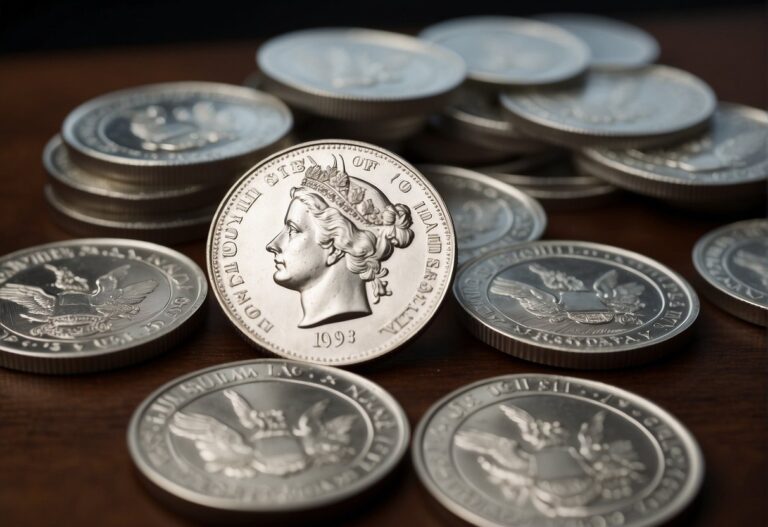A Gold IRA rollover is a strategy employed by individuals looking to diversify their retirement investment portfolio. It involves transferring assets from an existing retirement account, such as a 401(k) or a traditional IRA, into a self-directed IRA with gold as an investment.
Gold is often chosen for its historical stability and potential to protect against inflation and economic uncertainty, making it a favored option for those concerned about the long-term security of their retirement funds.
With a self-directed Gold IRA, investors can invest in physical gold, such as coins or bullion, rather than being limited to traditional paper assets. This move requires careful consideration of the rollover process, adherence to regulatory compliance, and an understanding of the potential financial implications.
The selection of a reputable custodian is also paramount, as they will facilitate the transfer of funds, hold the physical gold, and ensure that the investment complies with IRS guidelines. Proper risk management and strategic planning are essential to maximize the benefits of a Gold IRA rollover.
Gold IRA Rollover Key Takeaways
- A Gold IRA rollover allows for the diversification of retirement funds through investment in gold.
- The rollover process must comply with IRS regulations, necessitating a reliable custodian.
- Strategic planning is critical in managing risks and securing retirement savings within a Gold IRA.
Understanding Gold IRA Rollovers
When discussing retirement planning, the concept of a Gold IRA rollover takes center stage as a strategy that involves transferring retirement funds into a Gold IRA. This move may provide a hedge against inflation and diversify one’s portfolio.
What Is a Gold IRA?
A Gold IRA is an Individual Retirement Account facilitating investment in physical gold and other approved precious metals. Unlike a traditional or Roth IRA, which often consists of paper assets, a Gold IRA allows one to own tangible assets, providing a distinct approach to retirement savings. This type of IRA is typically self-directed, granting the investor more control over the investment choices.
Benefits of a Gold IRA Rollover
A Gold IRA Rollover involves transferring assets from an existing IRA or 401(k) to a Gold IRA. This process enables investors to protect their retirement portfolio from market volatility.
Diversifying one’s retirement assets by adding physical gold can protect against the devaluation of paper assets often associated with inflation.
A rollover to a Gold IRA also offers potential tax advantages, as the gold investment is made with pre-tax dollars and grows tax-deferred.
Gold IRA Rollover Process
A Gold IRA rollover involves transferring funds from an existing retirement account, such as a Traditional IRA or a Roth IRA, into a Gold IRA. This can be achieved via a direct or indirect rollover, depending on the account holder’s preference and the specifics of their retirement savings.
Direct vs. Indirect Rollover
Direct Rollover: A direct rollover occurs when the funds are transferred directly from one retirement account to another without the account holder taking possession of the funds. The current account provider sends the retirement savings directly to the Gold IRA custodian.
This process is straightforward, involves less paperwork, and has no tax implications if completed within guidelines.
Indirect Rollover: In an indirect rollover, the account holder receives a distribution from their existing IRA and must redeposit these funds into a Gold IRA within 60 days to avoid taxes and penalties.
It’s vital to understand that one can only perform one indirect rollover per 365 days across all IRAs, and any miscalculations can lead to unintended tax consequences.
Step-by-Step Gold IRA Rollover
- Choose a Gold IRA Custodian: Select a custodian specializing in Gold IRAs and open a new account. Consider looking into custodians with positive reviews, such as Trusted by 1000s With Their IRA.
- Initiate the Rollover: Notify the current IRA provider of the account holder’s intent to perform a rollover, specifying whether it will be direct or indirect.
- Select Gold Investments: Work with the new custodian to decide which gold assets—such as coins or bullion bars—to include in the Gold IRA.
- Complete the Transfer Process:
- For a direct transfer, complete the necessary forms with the current custodian to move the funds.
- For an indirect transfer, deposit the distributed funds into the new Gold IRA within the 60-day window.
- Confirmation: Obtain confirmation from the new Gold IRA custodian that the transfer is complete and the gold assets are secured in the account.
By following these steps, individuals can convert part of their existing retirement funds into gold, potentially providing a hedge against economic uncertainty.
Eligible Retirement Accounts
When considering a gold IRA rollover, knowing which types of retirement accounts are eligible for this process is essential. Not all accounts qualify, so identifying the proper ones is crucial in transferring towards a gold IRA.
Rollover From 401(k) to Gold IRA
A 401(k) plan, particularly an employer-sponsored 401(k), is one of the most commonly rolled-over accounts into a gold IRA. Employees with a traditional or Roth 401(k) can transfer their retirement funds into a gold IRA after leaving their job or retiring.
This move allows for the diversification of retirement savings and the inclusion of precious metals.
Other Qualifying Retirement Plans
Numerous other retirement plans also allow for rollovers into a gold IRA. The following outlines the major qualifying plans:
- Individual Retirement Accounts (IRAs): Traditional and Roth IRAs can be converted to gold IRAs.
- 403(b) Plans: Known as tax-sheltered annuities, employees of tax-exempt or non-profit organizations often hold these.
- 457(b) Plans: Offered to government and certain non-profit employees, these plans are also eligible for rollover.
- SEP IRAs: Simplified Employee Pension IRAs, used by self-employed individuals or small business owners, can be converted to gold IRAs.
- Thrift Savings Plan (TSP): This federal government-sponsored retirement plan is somewhat rarer but can be rolled into a gold IRA under certain conditions.
- Qualified Retirement Plans: These encompass a range of other employer-sponsored retirement plans meeting specific IRS guidelines and are typically eligible for rollover provided the individual has left employment or reached retirement age.
Adhering to the IRS guidelines is essential in any rollover process to prevent potential penalties or taxes. Consulting with a financial advisor or a company specializing in gold IRAs can ensure a smooth and compliant transition.
Choosing the Right Gold IRA Custodian
In the process of a Gold IRA rollover, selecting a reliable custodian is crucial for compliance and security. They are responsible for safeguarding assets and ensuring your investments meet IRS regulations.

Gold IRA Custodian Roles
A Gold IRA custodian is a financial institution that has received approval from the IRS to hold precious metals. Their roles include purchasing gold on your behalf, handling all the paperwork, and providing storage options. When choosing a custodian, it’s essential to confirm they offer:
- Compliance Assurance: They must adhere to IRS guidelines strictly.
- Security: Custodians should provide safe storage, often through third-party depositories.
- Transactional Efficiency: They should execute buy and sell orders promptly and accurately.
Reputable Gold IRA Companies
When investigating reputable Gold IRA companies, consider the following:
- Reputation & Track Record: Research customer reviews and company history. A reputable Gold IRA company often has robust positive feedback and a well-established presence in the industry.
- Financial Advisor Consultation: It may be beneficial to consult with a financial advisor who can help evaluate whether a company’s offerings align with your investment goals.
- Transparent Fee Structure: Look for a transparent pricing model, avoiding companies with hidden fees.
In summary, choosing the proper custodian involves due diligence to ensure they have a strong reputation, comprehensive custodian roles, and transparency.
A reputable Gold IRA company will provide peace of mind through its reliable track record and adherence to regulations.
Gold Investments and Options
When considering a Gold IRA rollover, investors have the opportunity to diversify their retirement portfolios by including a variety of precious metals. These investment choices range from physical metals like gold and silver to precious metals ETFs.
Types of Precious Metals
Gold and Silver are the most popular choices for investors holding physical precious metals. They can choose from gold coins, such as the American Eagle and Canadian Maple Leaf, or silver coins and bullion bars. Gold investments often act as a hedge against inflation and economic uncertainty.
Platinum and Palladium are less common but viable options for a precious metals IRA. Investors can purchase physical platinum or palladium coins and bars with market dynamics and investment potential.
Physical Gold vs. Precious Metals ETFs
Physical Precious Metals: Opting for tangible assets means investors can hold actual gold, silver, platinum, or palladium in their IRAs. This comes with the assurance of having a real asset, which can be appealing during financial instability.
Precious Metals ETFs: Alternatively, investors may choose precious metals ETFs (Exchange-Traded Funds), which offer exposure to the metals without the need to store physical products.
ETFs are typically more liquid than physical metals, making them easier to trade and potentially more suitable for short-term investment strategies.
Each investment option has distinct implications regarding liquidity, storage, and potential tax advantages, which should be carefully evaluated in an overall retirement strategy.
Gold IRA Regulatory Compliance
When undertaking a Gold IRA rollover, individuals must adhere to specific regulatory requirements to ensure the process is executed legally and to avoid potential tax penalties.
IRS Regulations and Rules
The Internal Revenue Service (IRS) mandates strict rules for Gold IRA rollovers. One central rule is the 60-day rule, which states that funds distributed from an IRA must be deposited into another qualified account within 60 days to maintain the tax-deferred status. Failed compliance can lead to tax penalties.
Additionally, there is an annual contribution limit for IRA deposits, and the type of rollover — direct or indirect — can influence the tax implications.
Purity Standards and Depositories
The IRS requires a particular purity level for gold and other precious metals to qualify for a Gold IRA. Specifically, gold must be 99.5% pure, while silver, platinum, and palladium require a purity of 99.9%. Only certain forms of these metals are acceptable.
All investments must be held in an approved depository, making them safe and authorized by relevant institutions to ensure security and compliance. These depositories must also provide strict measures to protect the physical investments.
Financial Implications
When considering a Gold IRA rollover, it’s crucial to understand the tax implications and associated costs of this form of investment to make a well-informed decision.
Gold IRA Tax Benefits and Consequences
Transferring funds from a traditional retirement account into a Gold IRA offers tax-deferred or tax-free growth, depending on the type of account being rolled over.
Rollovers from conventional IRAs maintain their tax-deferred status, meaning taxes are due when withdrawals are made.
Conversely, rollovers from a Roth IRA are typically tax-free as contributions have already been taxed. It’s important to note that any tax implications are often defined by specific IRS rules concerning rollovers; failing to adhere to these rules, such as the 60-day rule for indirect rollovers, can lead to taxes and penalties.
Understanding Costs and Fees
Investing in a Gold IRA may involve several fees that can affect one’s retirement savings. The costs include but are not limited to, setup fees for creating the IRA, storage fees for the physical gold, and potential seller’s fees. Here’s a basic breakdown:
- Setup Fees: One-time fee to establish your Gold IRA.
- Storage Fees: Recurring charges for safeguarding the physical metals.
- Annual Fees: Administrative costs charged by the custodian.
- Seller’s Fees: Also known as spreads, they are the cost above the spot price of gold.
Prospective investors must ask about all associated fees before weighing them against the long-term tax benefits to ensure that the investment aligns with their financial goals.
The key advantages are the avoidance of tax withholding on rollovers and the potential to defer taxes until retirement age.
However, one must calculate whether these benefits outweigh the costs of a Gold IRA.
Gold IRA Risk Management
Investing in a Gold IRA can be a strategic move to manage financial risks. This section looks at how gold serves as a stabilizer within an investment portfolio.
Diversifying Your Portfolio
Diversification is fundamental in mitigating risk; spreading investments across different asset classes can reduce the potential impact of poor performance on any asset. In terms of a Gold IRA rollover, it can add a non-correlated asset, which historically moves inversely to paper investments. This means gold could retain or increase its value when stocks or bonds decline.
Mitigating Market Volatility
Market volatility reflects the frequency and magnitude of asset price fluctuations, often influenced by economic indicators, geopolitical stability, and market sentiment. A Gold IRA can act as a haven during periods of high volatility, providing a cushion against the erratic movements of the stock market.
This is because gold is viewed as a reliable store of value that has withstood inflation and preserved wealth over centuries.
An investor’s risk tolerance may dictate the proportion of gold in their portfolio, aiming to align with their long-term investment goals.
Strategic Planning
Strategic planning is crucial in retirement, aligning one’s investment strategy with financial goals and pursuing a secure retirement. A well-constructed retirement plan positions an individual to achieve long-term retirement objectives.
Setting Financial Goals
One initiates strategic planning by setting clear financial goals. These targets act as benchmarks for measuring the progress of one’s investment efforts and help maintain focus over the long term. Specific goals might include a targeted retirement age or desired retirement savings, which will shape the approach to a Gold IRA rollover.
- Short-term goal: Accumulate a specific sum of funds within five years.
- Mid-term goal: Diversify retirement portfolio with precious metals by a specific date.
- Long-term goal: Reach a retirement savings target that ensures a comfortable lifestyle.
Long-Term Retirement Strategy
Building a long-term retirement strategy is integral to a Gold IRA rollover concept. It should incorporate diverse investments that can withstand market fluctuations and provide stability. Including assets like gold is a strategic move, as they typically have a lower correlation to stocks and bonds and could safeguard against inflation.
- Asset allocation: Determine the percentage of gold relative to other assets in the retirement portfolio.
- Risk assessment: Continuously evaluate the risk profile and adjust the investment mix.
- Performance review: Regularly review the performance of the gold IRA assets to ensure they align with the set retirement goals.
Securing Your Retirement With a Gold IRA
In the journey towards retirement, incorporating tangible assets into one’s retirement portfolio can enhance stability against economic uncertainty. These assets often retain intrinsic value and can protect savings from market volatility.
The Role of Tangible Assets
Tangible assets, like precious metals, play a pivotal role in shielding retirement savings from the unpredictable nature of financial markets. Companies such as Goldco and Augusta Precious Metals specialize in adding these types of assets to retirement accounts. They enable investors to include gold, silver, and other metals in their savings strategy, which historically have been a hedge against inflation and economic downturns.
Building a Resilient Retirement Portfolio
Diversification is crucial to constructing a resilient retirement portfolio. It involves having various asset types to minimize risk exposure. A retirement account managed by firms like Equity Trust can hold various investments, including stocks, bonds, and tangible assets.
Integrating physical gold into one’s retirement savings account through a gold IRA rollover is a strategic method to balance a portfolio, aiming to secure financial stability for the future while mitigating the effects of market fluctuations and preserving purchasing power.
Gold IRA Rollover Frequently Asked Questions

Investors commonly encounter critical questions when navigating the intricacies of gold IRA rollovers. This section addresses those key concerns, offering clear and precise responses to enhance understanding of the process and implications.
How do you transfer a 401k to a gold IRA without incurring penalties?
To transfer a 401k to a gold IRA without penalties, an individual should conduct a direct rollover, transferring funds directly from the 401k plan to the gold IRA. This method avoids potential taxes and early withdrawal penalties that can occur with indirect rollovers.
What are the benefits and drawbacks of investing in a gold IRA?
Investing in a gold IRA can provide portfolio diversification and protection against inflation and economic downturns, highlighted asset protection. However, drawbacks may include potentially higher fees than traditional IRAs and the lack of dividends that stocks can provide.
How does a gold IRA differ from investing in physical gold?
A gold IRA offers a tax-advantaged way to own physical gold through an investment account, whereas a direct physical gold investment lacks these tax benefits and requires secure storage.
The gold IRA aligns with retirement planning while owning physical gold offers liquidity and direct control.
What steps are involved in executing a gold IRA rollover?
A gold IRA rollover generally involves selecting a gold IRA custodian, opening a new IRA account, funding the account via transfer or rollover, and purchasing gold with the IRA funds. Companies like the Oxford Gold Group provide an outline of these steps.
Is it possible to withdraw from a gold IRA, and what are the implications?
Withdrawals from a gold IRA are possible but are subject to tax implications and potential penalties if they occur before the age of 59 and a half.
I think it’s essential to work with a tax advisor to understand specific circumstances.
How does investing in a gold IRA compare to a traditional 401k regarding retirement planning?
A gold IRA can hedge against market volatility and inflation, a diversification strategy different from the traditional 401k’s typical investments in stocks, bonds, and mutual funds.
Investors often compare gold IRAs and 401(k)s when considering the balance between risk and security in their retirement portfolio.



